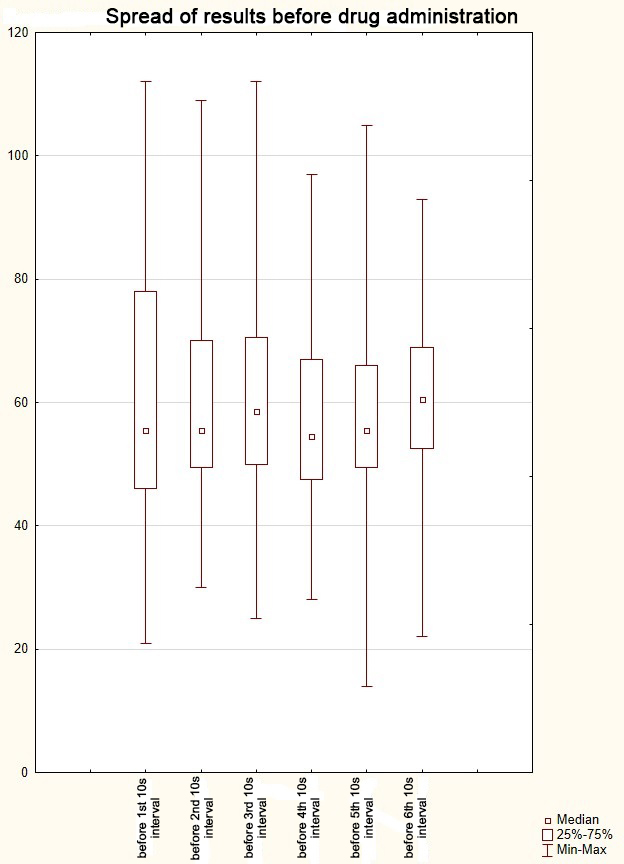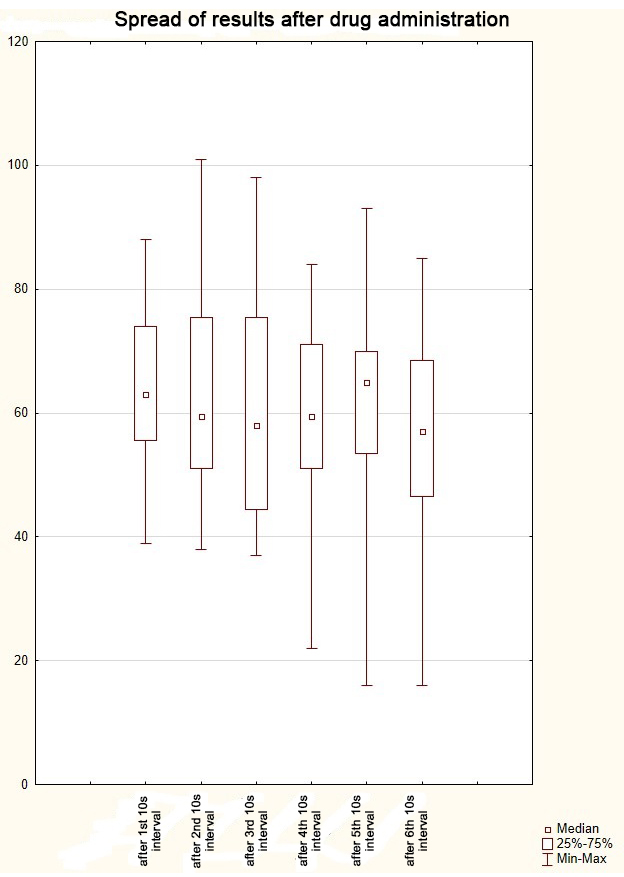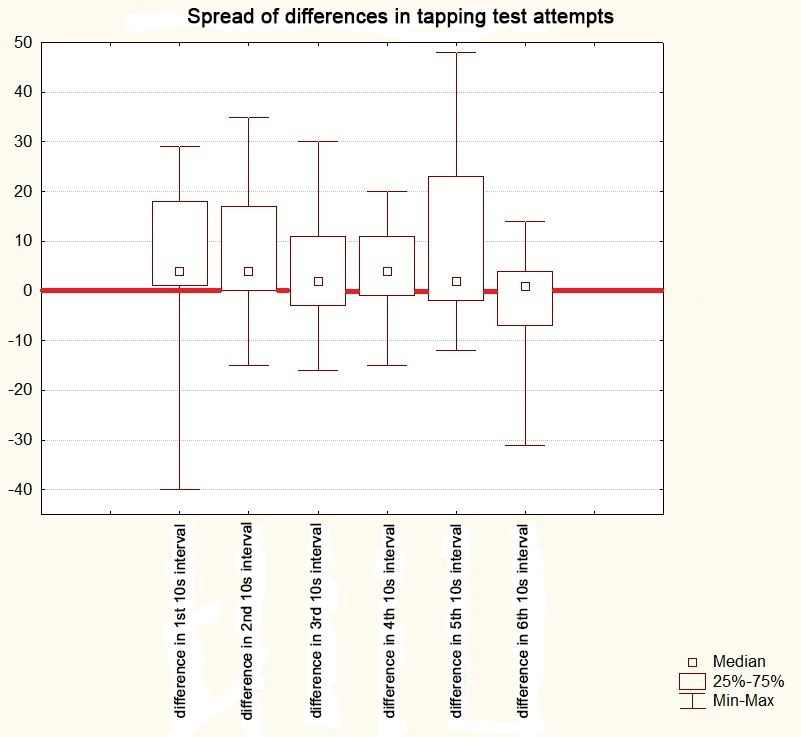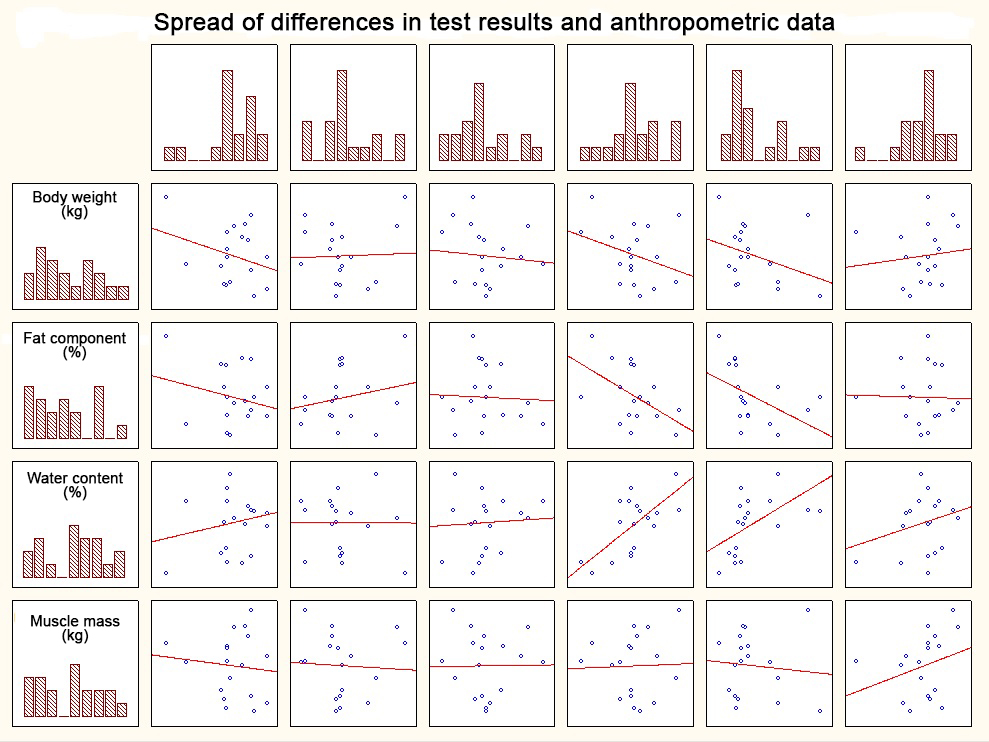Neuropeptide effects on movements pace in archery
Фотографии:
ˑ:
Dr.Biol., Professor R.V. Tambovtseva1
Master's student D.I. Sechin1
1Russian State University of Physical Education, Sports, Youth and Tourism (SCOLIPE), Moscow
Keywords: Semax, neuropeptides, pace, ergogenic tools, sports.
Introduction. As yet, little attention has been given in the scientific and scientific-methodological literature to the problems of optimization of movement pace in archery. Individualized correction of pace is only possible if based on rationalization of pharmacological support of athletes [3-5, 9, 10]. Adrenocorticotropic hormone can be deemed as a means of correction of individual characteristics of pace as it is a neuropeptide that activates attention and memory [2]. "Semax" medication, which is an adrenocorticotropic hormone fragment, is the most promising domestic development, which does not have any foreign analogues, [1, 2, 6]. By its classification the active substance of the neuropeptide "Semax" belongs to the melano corticotropin family and corticotrophin group, of which adrenocorticotropin and its fragments are its representatives [2]. Adrenocorticotropin is a pituitary hormone, which stimulates the adrenal glands to secrete corticosteroid, has a direct effect on the level of attention to external signals, as well as on memorization and learning. Individual fragments play a key role in certain processes [2]. In this regard, "Semax" is an easy-to-use drug as it is a synthetic analogue of the adrenocorticotropic hormone, but it does not have any side effects or hormonal activity.
Objective of the study was to rate immediate effects of the Semax 0.1% single administration on the archers’ hand movement pace.
Methods and structure of the study. This experiment was carried out at the Muscular Activity Bioenergetics Laboratory of the Sport Biochemistry and Bioenergetics Department named after N.I. Volkov. The work was performed at no risk for human health in compliance with the internationally accepted provisions on humanity and ethical standards as provided by the 2000 Helsinki Declaration and EU Directive 86/609. The subjects gave their informed consent for participation in the experiment. At baseline, all athletes were healthy. The study involved 23 high-skilled athletes who took the medication, and 10 archers who took placebo. The athletes’ hand movement pace was determined using the hardware and software complex "Sports psychophysiologist" [7, 8], which made it possible to rate the immediate effects of the Semax 0.1% administration on the tapping test results. The Semax 0.1% preparation meets the basic requirements for ergogenic drugs, namely: it does not appear on the list of drugs banned by WADA; ensures high efficiency of the physiological and metabolic processes; does not cause undue inconvenience or extreme situations, does not cause urgent or delayed negative consequences for the athlete’s health, excessive or long-term decrease in the physical fitness level; has no evidence of negative results in the literature. The experimental program consisted of the task instruction, answers to the questions arising during testing on the hardware and software complex, intranasal introduction of the drug in the doze of 500mkg of the active substance divided into two administrations at 10 m intervals. The athletes’ anthropometric characteristics were determined using the BC-543 fat analyzer (Dongguan Tanita Health Equipment Co).
Results and discussion. The analysis of the obtained statistical data failed to reveal any statistically significant differences in the psychophysiological tests between the experimental group and placebo group at the beginning of the experiment (p>0.05). Based on the analysis of the results obtained on the second attempt, the study sample was found to have statistically significant differences (p<0.05) in the reaction and hand movement pace values.
The next stage of our research was to provide a graphic representation of the data obtained before and after the drug administration with the help of the hardware and software complex STATISTICA (Figures 1 and 2).

Fig. 1. Diagram of spread of tapping test results before drug administration

Fig. 2. Diagram of spread of tapping test results after drug administration
Basing on the visual analysis results presented in Fig. 1 and 2, we tried to diagram the spread of differences between these results in both attempts, as shown in Fig. 3.

Fig. 3. Diagram of spread of differences in tapping test attempts
Commenting on Fig. 3, it should be noted that the negative values indicate a decrease in the tapping test results after the Semax 0.1% administration, while the positive results, on the contrary, testify to the positive effect of the drug on the hand movement pace. As seen froem th Figure, in all cases the median characterizes the positive effect of the Semax 0.1% preparation on the hand movement pace, however, in some cases, a negative effect is observed.
For the purpose of a more in-depth analysis of the data obtained, we conducted a correlation analysis of the differences between the tapping test results and anthropometric data. Initially, we performed a visual analysis of the data presented in the form of the diagram of the spread of differences between the athletes’ test results and anthropometric data (Figure 4).

Fig. 4. Diagram of spread of differences in test results and anthropometric data
The visual analysis of the data was followed by the correlation analysis, the results of which are presented in Table 1.
Table 1. Results of correlation analysis of differences between test results and anthropometric data of the subjects
|
Correlations Marked correlations are significant at p<0.05000 n=19 |
||||
|
Weight (kg) |
Fat % |
Water % |
Muscle mass (kg) |
|
|
Difference in the 1st 10s interval |
-0.2971 |
-0.2242 |
0.1938 |
-0.1089 |
|
p=.217 |
p=.356 |
p=.427 |
p=.657 |
|
|
Difference in the 2nd 10s interval |
0.0392 |
0.2081 |
-0.0048 |
-0.0591 |
|
p=.873 |
p=.393 |
p=.985 |
p=.810 |
|
|
Difference in the 3rd 10s interval |
-0.0978 |
-0.0446 |
0.0602 |
0.0119 |
|
p=.690 |
p=.856 |
p=.807 |
p=.961 |
|
|
Difference in the 4th 10s interval |
-0.3356 |
-0.5384 |
0.701 |
0.0356 |
|
p=.160 |
p=.017 |
p=.001 |
p=.885 |
|
|
Difference in the 5th 10s interval |
-0.3404 |
-0.478 |
0.5548 |
-0.0995 |
|
p=.154 |
p=.038 |
p=.014 |
p=.685 |
|
|
Difference in the 6th 10s interval |
0.1173 |
-0.0227 |
0.251 |
0.2836 |
|
p=.633 |
p=.927 |
p=.300 |
p=.239 |
|
Conclusion. Basing on the analysis of the data obtained, it can be concluded that:
- the Semax 0.1% administration was found to moderate the hand movement pace in six ten-second test intervals;
- in terms of the raised up type (strong type of the nervous system, n=4) an increase is observed in the movement pace in the first 3 time intervals in relation to the baseline indices, while the dynamics of the maximum pace does not change;
- in terms of the flat type (normal type of the nervous system, n=7), the maximum pace increases throughout the minute relative to the baseline indices in 4 out of 5 cases;
- in terms of the descending type (weak type of the nervous system, n=12), the drug administration changed the type of dynamics of the maximum pace, up to the correspondence to the convex type, which is typical of people with a strong nervous system;
References
- Aksenova I.N. Izmenenie funktsionalnogo sostoyaniya operatorov EVM pod vliyaniem fizicheskikh trenirovok s elementami lechebnoy gimnastiki i priema semaksa. Avtoref. dis. kand. med. nauk [Change in functional state of computer operators under physical training with elements of therapeutic gymnastics and Semax intake. PhD diss. abstract]. Moscow, 1993, 20 p.
- Ashmarin I.P. Neyrokhimiya. Uchebnik dlya biologicheskikh i meditsinskikh vuzov [Neurochemistry. Textbook for biological and medical universities]. Moscow: Institute of Biomedical Chemistry, Russian Academy of Medical Sciences publ., 1996.
- Belenichev I.F. Sovremennye nootropnye preparaty: klassifikatsiya, mekhanizm deystviya, perspektivy primeneniya [Modern nootropic drugs: classification, mechanism of action, prospects of use]. Zaporozhskiy meditsinskiy zhurnal, 2010, vol. 12, no. 5, pp. 122-126.
- Volkov N.I., Voytenko Y.L., Tambovtseva R.V. Problemy ergogennykh sredstv i metodov trenirovki v teorii i praktike sporta vysshikh dostizheniy [Problems of ergogenous methods and techniques of training in theory and practice of elite sport]. Teoriya i praktika fiz. kultury, 2013, no. 8, pp. 68-72.
- Volkov N.I., Oleynikov V.I. Ergogennye effekty sportivnogo pitaniya: nauchno-metodicheskie rekomendatsii dlya trenerov i sportivnykh vrachey [Ergogenic effects of sports diet: theoretical and methodical recommendations for trainers and sport physicians]. Moscow: Sovetskiy sport publ., 2012, 100 p.
- Ganapolsky V.P. Razrabotka novykh peptidnykh preparatov. Avtoref. dis. dokt. med. nauk [Development of new peptide preparations. Doct. diss. (Med.) abstract]. SPb., 2008, 37 p.
- Koryakina Yu.V. Apparatno-programmnye kompleksy issledovaniya psikhofiziologicheskikh osobennostey sportsmenov [Hardware-software complexes to study psychophysiological characteristics of athletes]. Voprosy funktsionalnoy podgotovki v sporte vysshikh dostizheniy, 2013, vol. 1, no, 1, pp. 70-78.
- Koryakina Yu.V. Apparatno-programmny kompleks «Sportivny psikhofiziolog» (APK «Sportivny psikhofiziolog») # 2010617789 [Hardware and software complex "Sports psychophysiologist" (ASC "Sports psychophysiologist") № 2010617789]. Computer programs. Database. Topologii integralnykh mikroshem, 2011, no. 1, vol. 2, P. 308.
- Makarova D.A. Vliyanie nootropnykh preparatov na uspevaemost studentov [Nootropic drugs versus students’ progress]. Bulletin of medical Internet conferences. LLC ‘Nauka i innovatsii’, 2015, vol. 5, no. 12.
- Tambovtseva R.V. Sportivnaya ergogenicheskaya dietetika. Ucheb. posobie [Sports ergogenic dietetics. Study guide]. Moscow: OntoPrint publ., 2016, 151 p.
Corresponding author: ritta7@mail.ru
Abstract
The experimental study was designed to rate the effects of Semax neuropeptide on the archers’ movement pace, with a computerized tapping tests applied for the pace rating purposes. The Semax 0.1% administration in the doze of 500mkg was found to cause changes in the hand movement pace in the six ten-second test intervals. The Semax 0.1% administration was tested to be in the positive correlation with the maximal hand movement pace, reduction of relative body fat mass and relative water content. The study data and analyses show the need for a higher priority to be given to the studies of the effects of different neuropeptides on the physical working capacity.



